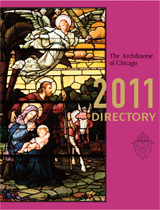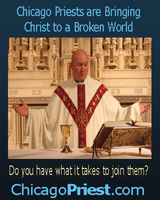A man with hands blessed by a pope Artist John David Mooney heads to Vatican for meeting with pontiff

A regular feature of The Catholic New World, The InterVIEW is an in-depth conversation with a person whose words, actions or ideas affect today's Catholic. It may be affirming of faith or confrontational. But it will always be stimulating.
When John David Mooney was fresh out of college at the University of Notre Dame, he headed to Rome as an artist-in-residence with the Second Vatican Council.
It was the best education he had, Mooney said. And it ended with Christmas Mass with Pope Paul VI and a private audience. The young artist had met the then- Cardinal Giovanni Montini a few years before at Notre Dame and the pope recalled the meeting and asked Mooney a question.
“It was the nicest thing. He said, ‘What can the pope do for you?’ And I simply said ‘Take my hands, your holiness. Bless them that I can do the Lord’s work.”
Mooney has been working and creating ever since (his work includes a sculpture on the southwest lawn of the Adler Planetarium and a set of hand-sewn vestments for Old St. Patrick Parish), most often in a secular environment but always with his heart tuned to the Lord.
Mooney is one of more than 260 painters, sculptors, dancers, actors, playwrights, musicians, architects and other artists that accepted a Vatican invitation to meet Nov. 21 with Pope Benedict XVI.
The gathering under Michelangelo’s frescoes in the Sistine Chapel will bring the artists together to mark the 10th anniversary of Pope John Paul II’s letter to artists and the 45th anniversary of Pope Paul VI’s meeting with artists.
Among the attendees is Anish Kapoor, who created Cloud Gate (“The Bean”) in Millennium Park.
Cardinal George wrote a letter recommending Mooney to attend the meeting and noted the artist’s sculpture installations at the Vatican Observatory at Castle Gandalfo in Italy.
For Mooney, the meeting brings him full circle since it was Paul VI’s 1964 meeting that inspired him to go to Rome for the year in residence.
Mooney recently spoke with the Catholic New World about faith, art, architecture and the divine.
Catholic New World: You have talked before about the relationship between faith and art.
John David Mooney: It’s pretty hard to separate the two. It all comes from the same source so it’s all one channel. We like the division of faith and reason, faith and science, faith and art. It’s the rational approach to how we discover and explore.
And it fits better into our language because we are working with people who have either denied or believe there is no evidence of faith. But it all comes from one source.
You know that your faith comes from down deep within you. Whether there are moments of doubt or what, there is a well there from which this is coming. I believe that all seekers of knowledge are going to that same well.
You can put a pair of blinders on when you are searching for truth that you go only for this one aspect not seeing the broader picture… You may lose track of where that search began in the first place, what is driving you to come to grips to know.
The quest for the unknown, whether it’s in science or art, is a quest for beauty at the same time, that constant of truth. That’s the same quest for faith. At least mine is, it’s wrapped in the beauty of the entire redemption.
CNW: Why are patrons important to art?
Mooney: Many times the artist, the scientist, the thinker is working against the current. Any periods of deep growth come from the collaborative spirit of the patron, the person who asks for you to think about doing something.
It’s the patron that is equal if not more important than the artist to start with. So great art comes with great patronage.
That’s what this encounter is with this Vatican invitation. They want to say that they are willing to be patrons. I think that’s what they are saying or they wouldn’t quite put themselves on the line.
It was really obvious with Paul VI. He had a visible love affair with art. He knew it. He could tell it. He commissioned Pier Luigi Nervi to do his audience hall. He created a wing of the Vatican Museums for contemporary art.
He wasn’t about what their source was. He was about “We are responding to your art.” He was really major....
The church itself has to be one with the art. It always comes from the major patron.
When you study your early Christian art, you realize that they immediately developed an iconography first from Greek art and then began to invent a new expression, built upon earlier aspects. But it was one with the community of the church. It was obviously one expression so the patronage was there.
Our major church form that is borrowed over and over again, is of the gothic church. And it’s pretty poor and pretty run down but think of Abbot Suger who actually invented and created this.
It all comes from one brilliant abbot who was able to put these art forms together... And had a blossoming which, unfortunately we’re still borrowing from. It’s like worn out tires.
CNW: Can we get better?
Mooney: Only if there is an enlightened patron. … It can’t be one group of people in one city. It’s got to be universal. There has to be that patronage across the board. The dialogue has to be at every level.
With that then it becomes exciting. We have people [today] asking that art give them a spiritual base and what have they done? They have, in the last 30 years, built a plethora of art museums across the country and these art museums are replacing the churches. Totally opposite. They are packed on Sundays in fact. They are the new temple.
And people are going there I think for at least a sense of enlightenment. It’s not dedicated to quiet, daily, monastic prayer but it is to that explanation of “God is great” and we give glory to that fact. The whole first part of the Mass is praising and giving glory to God. All of that precedes even listening to the Gospel. That’s what the art function is.
Legacy in fabric
When Old St. Patrick’s parishioner Denise Stauder received some money through an inheritance, she wanted to use the funds to create something as a legacy for her family, who were Chicago-area settlers. She asked Father John Cusick of Old St. Pat’s what the parish needed and he suggested new vestments to complement the church’s renovated interior.
Instead of just purchasing vestments from a company, Stauder said she thought of her artist friend John David Mooney. She described Mooney as a “very spiritual man.” “He’s very creative and esoteric and a little bit of a curmudgeon. He’s a typical artist,” she said. “He’s got a great heart and an absolutely expansive mind.”
Designing vestments and working with textiles was a new avenue for the installation artist and sculptor but the effort was worth it.
“The emotions that those vestments elicit are totally different for everyone who sees them,” said Stauder.
The complete set of liturgical vestments is nearly done. Mooney is putting the finishing touches on the Advent vestment and may create a second one for Ordinary Time.
Each is almost a mini homily with the theme around the Old Testament root of Jesse, Stauder said. The Ordinary Time vestment is inspired from the cross at Old St. Patrick’s.
“When you look at those vestments it’s all the creation story,” she said. “There’s so much symbolism that is in every one of those vestments.”
Stauder said people have told her looking at the vestments on the priests during Mass makes a difference in how they pray.
Mooney made the designs and hired on Lois Kendellen and Wanda Menghini as seamstresses. The women spent countless hours cutting out the different pieces of fabric to match the original designs and then sewed the vestments by hand.




